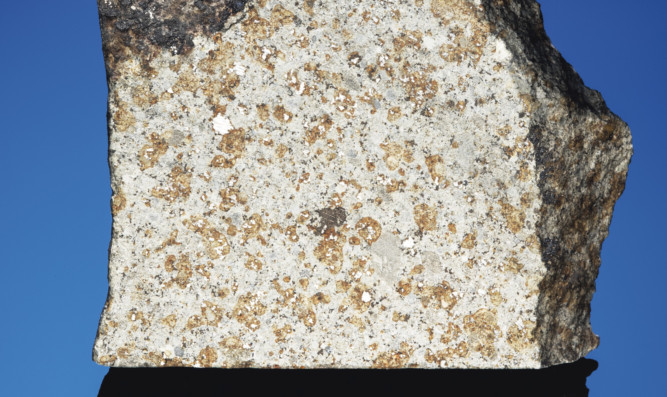It came from outer space … and landed in Perthshire.
Now almost 100 years after the so-called Strathmore Meteorite crashed with a thud during the First World War, a thick slab is set to fetch between £10,000 and £15,000 at auction.
Auctioneers Christie’s of London will put it under the hammer on April 20.
It measures two-and-a-quarter inches across and weighs 95.9 grams.
The meteorite appeared as a brilliant fireball on December 3 1917, entering the atmosphere east of Dunbar and passing over Fife and the Sidlaws Hills.
It broke apart in the sky with four stones weighing a total of approximately 13kg recovered.
Three of the stones were found in Perthshire at Easter Essendy, Carsie and Keithick and one in Forfarshire at South Corston.
Nearly 10kg of the Strathmore Meteorite is at the National Museum of Scotland, while the fragment found at South Corston Farm, near Coupar Angus, is on display at Perth Museum and Art Gallery.
The slab up for sale is from the Natural History Museum in London.
James Hyslop, meteorites expert at Christie’s said: “The rarity of the Strathmore meteorite lies in its Scottish origins.
“Because of its size, compared to the rest of the world, Scotland makes for a very small target. For this reason meteorites are very rare.”
The Strathmore meteorite is 4.5 billion years old and dates to the formulation of the Solar System.
It was travelling at about 30,000 miles an hour before it landed in Perthshire.
According to Perth and Kinross Council records it was “a cold, clear winter day” when the meteorite crashed to earth and many people in east central Scotland witnessed it fall, leaving a bright trail across the sky.
Earlier this year, at about 6.45pm on February 29, a “big white flash” was seen by people in Inverness, Forres and Kinloss.
Professor Keith Horne of St Andrews University said at the time it could have been caused by a meteor travelling at about 30 kilometres per second.
There have been only a handful of confirmed meteorite falls in Scotland.
These include High Possil, Glasgow in April 1804; the Perth Meteorite in 1830 and the Strathmore Meteorite in 1917.
Fragments of a meteorite were found in a field near Glenrothes but the precise date of the landing is not known.
